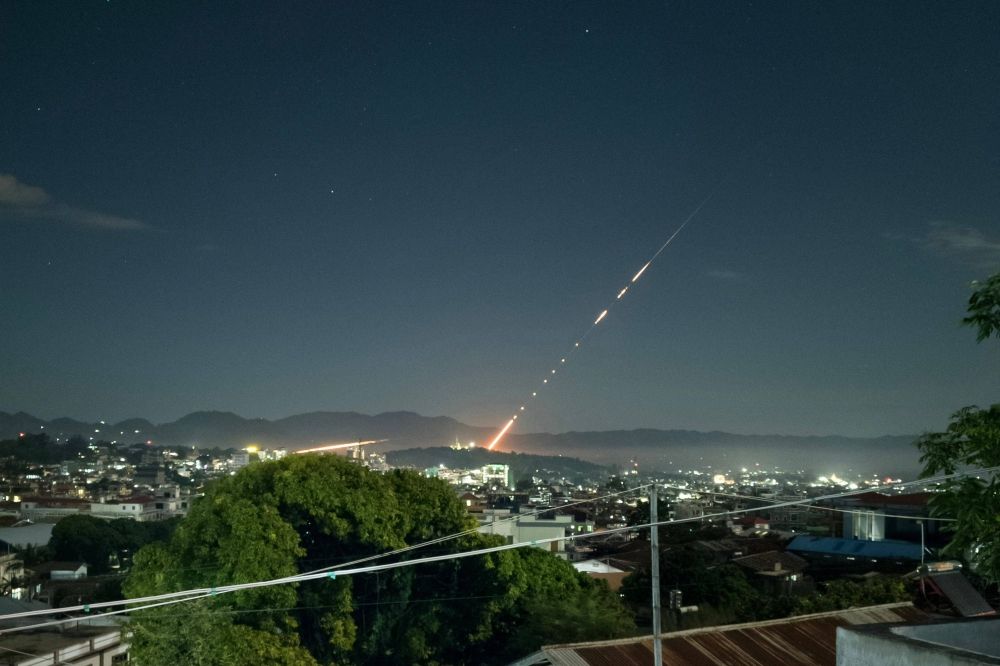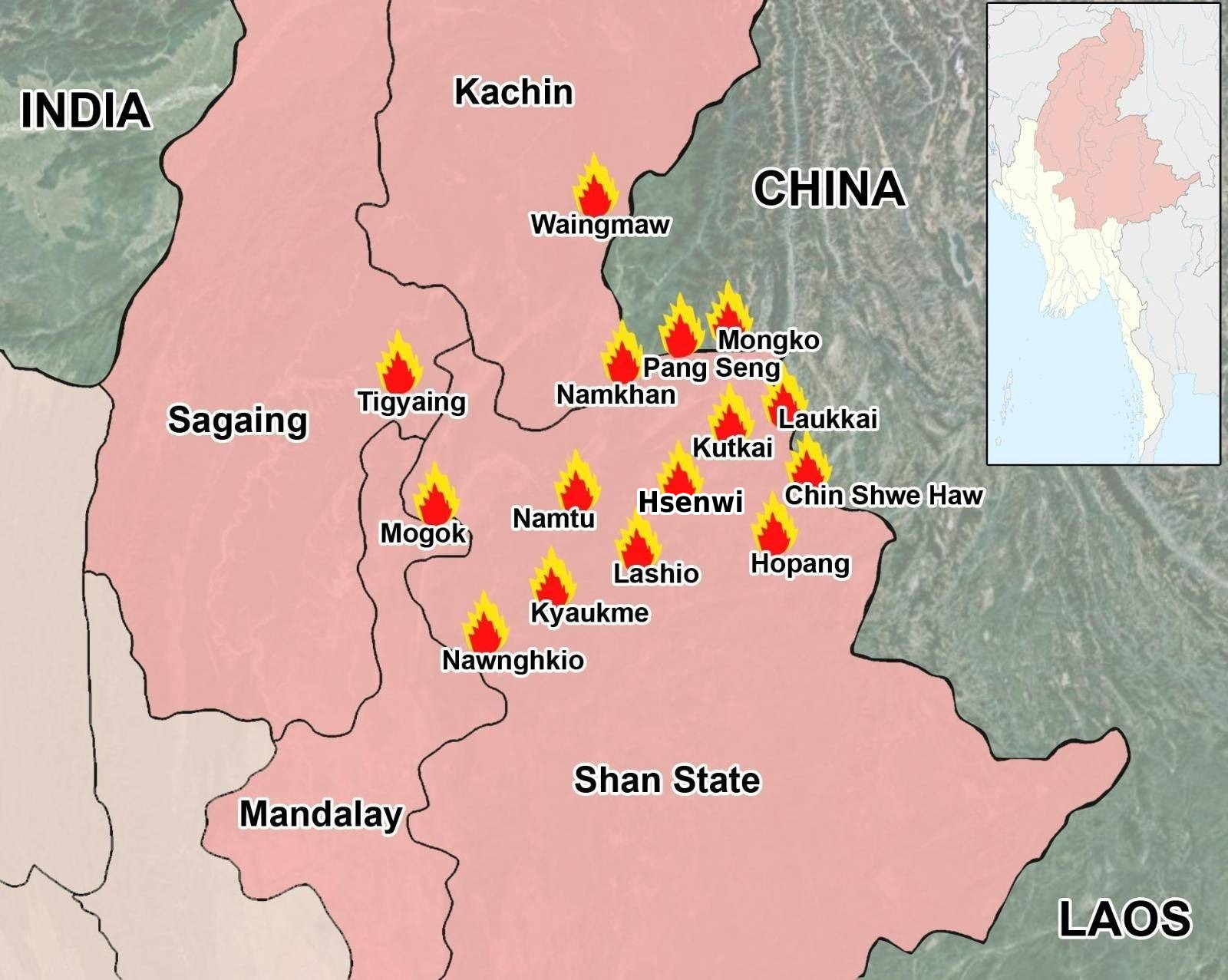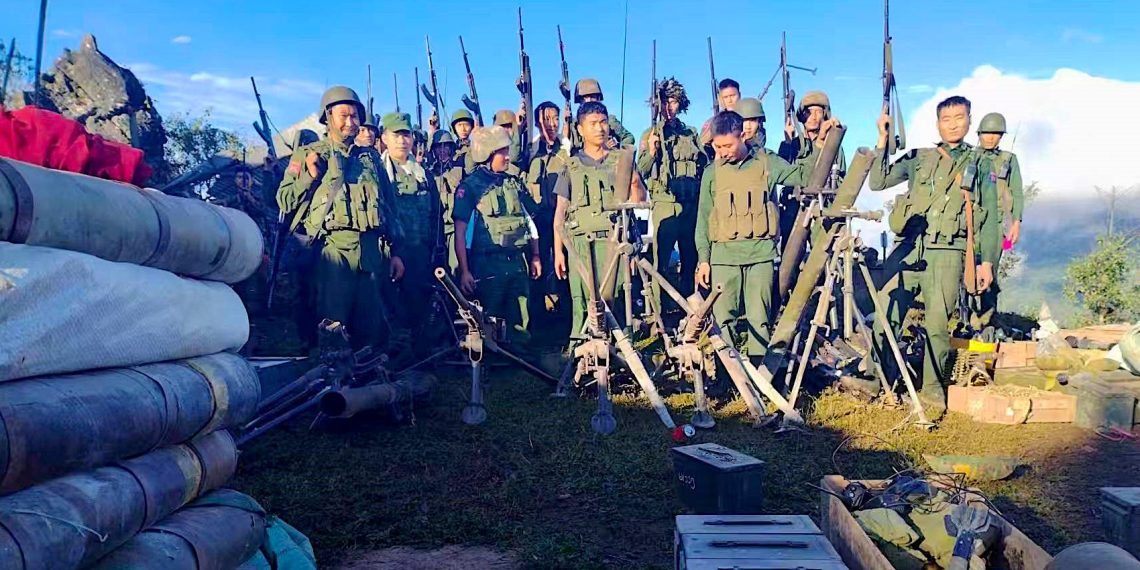It has been more than 10 days since the Brotherhood Alliance launched its Operation 1027 in northern Shan State in eastern Myanmar. Thus far, junta boss Min Aung Hlaing has only been able to issue verbal threats to strike back at the tripartite military alliance made up of the Myanmar National Democratic Alliance Army (MNDAA), the Ta’ang National Liberation Army (TNLA) and the Arakan Army (AA).
Biggest challenge since coup
The regime lost around 100 outposts in a week, and the ethnic alliance seized a haul of weapons. The junta’s bases in Kunlong, Monekyat, Nanbeng (on Lashio-Tangyan Road) and Monekoe were the only ones that managed to resist the offensive, with the regime losing most of its outposts in the area with a speed no one previously imagined possible. The regime has also lost at least six tanks and armored vehicles, and the Myanmar military has admitted it no longer has control of Chin Shwe Haw, Pansai and Phaung Sai towns.
The ethnic alliance has taken control of Hsenwi north of the Namtu River, but junta troops maintain a defensive position south of the river. Some junta outposts have fallen in Monekoe, but the junta hill-top outpost that houses the tactical command remains intact.
Communication networks in northern Shan State have been disrupted, border trade through the 105th Mile Camp, Muse, Jinsanjiao and Chin Shwe Haw has halted, and junta government employees have fled their offices.
The regime has only been able to maintain its administrative mechanism in Lashio, Hsipaw, Tangyan, Hopan and Panlong, and has lost control of many towns including Chin Shwe Haw, Kunlong, Hsenwi, Kutkai, Muse, Pansai, Paungsai, Kyaukme and Nawngkhio in northern Shan State.
Myanmar military’s response

The Myanmar military has airlifted reinforcements to Lashio and Kunlong as well as to the 16th Military Operations Command in the south of Hsenwi. It is also airlifting and parachuting food supplies and ammunition to its outposts in northern Shan State that have been cut off by the ethnic alliance.
It also dispatched some combat forces including tank units from Pyin Oo Lwin in Mandalay Region to attack Nawnghkio in northern Shan, but the reinforcements were intercepted by combined forces of the Mandalay People’s Defense Force and the TNLA and have not been able to advance to the town.
The regime is still struggling to mount a counterattack nearly two weeks after the launch of the offensive.
Operation 1027 has again highlighted the Myanmar military’s serious shortage of personnel. Junta reinforcements airlifted to Lashio come from southern Shan and Kayah (or Karenni) states. The troops dispatched from Pyin Oo Lwin are from the 101st Light Infantry Division based in Pakokku but number less than 150, and it is very unlikely they will be able to repulse the resistance attacks and push their way through to Nawnghkio.

The regime is not in a position to bring in as many reinforcements as it would like into northern Shan State. Fighting a multi-front war in Kachin, Karen and Chin states and Magwe, Sagaing, Mandalay, Bago and Tanintharyi regions, it might not want to risk new fronts in Rakhine and southern Shan states. Rakhine State is home to the AA, which is a member of the Brotherhood Alliance, while the Shan State Progress Party (SSPP), an ally of the Brotherhood Alliance, has a strong presence in southern Shan State.
With the Kachin (Kachin Independence Army), Ta’ang (TNLA) and Kokang (MNDAA) ethnic armed groups having seized one area after another in northern Shan State, the SSPP might not be willing to just sit and watch on the sidelines. Notably, while the AA has openly admitted that it is involved in fighting not only in Kachin but also in northern Shan State and Sagaing Region, the regime has blamed the KIA, MNDAA and TNLA for the offensives but has not said a single word about the AA.
The Myanmar military once refused to allow the AA to participate in national-level peace talks known as the Union Peace Conference, demanded its disarmament and forced the then-civilian government—which it later ousted—to declare it a terrorist organization. But its unwillingness to complain about the Rakhine ethnic armed group now is an indication that the Myanmar military dreads opening a new front in Rakhine, and is short of personnel.
The regime, apparently also concerned that the United Wa State Army and National Democratic Alliance Army—political allies of the Brotherhood Alliance—will join the offensive, recently re-blocked roads between Mongla and Kengtung.
It is also reportedly arranging to gather around 20 battalions, or over 20,000 troops, to strike back against Operation 1027.

The combined forces of the Brotherhood Alliance, People’s Defense Force, People’s Liberation Army and Burma People’s Liberation Army currently fighting in northern Shan State total around 20,000. So, the regime needs to mobilize at least 20,000 troops. However, the escalating fighting in Kachin, Karen, Kayah and Chin states and Sagaing, Magwe, Mandalay and Bago regions means the regime will likely not be able to do so. Moreover, the nature of the fighting has changed in Sagaing and Magwe regions, with resistance forces now aiming to seize towns and more strategic junta bases. This is well beyond what the junta’s air force can handle, not to mention its ground reinforcements.
In response, the Myanmar military has told its troops manning smaller outposts to retreat and join bigger strongholds. It is not in a position to take back control of the Muse-Chin Shwe Haw road, a key route for border trade with China, let alone recapture all the outposts seized by the Brotherhood Alliance.
Namhkam and Monekoe are also under siege, and the regime has not yet been able to send reinforcements.
Ceasefire?
Spokespeople for China’s Foreign Ministry have twice called for an end to the fighting in northern Shan State and for dialogue.
It is only natural that China wants stability along its border, and a resumption of border trade. But it is unlikely that the fighting in northern Shan State will come to an end in the near future.
The Brotherhood Alliance has seized towns and over 100 outposts. It is unlikely that it will withdraw from them to hold talks with the regime. For its part, the regime can’t give up on trying to take back the towns, because that would mean ceding control of border trade with China to the alliance. So it will attempt to retake the towns and outposts.
Secondly, it seems Operation 1027 has not yet achieved its military objective. The Brotherhood Alliance apparently wants to establish a contiguous area under its de facto control.
Under such circumstances, it is unlikely that the regime and the Brotherhood Alliance will stop fighting in northern Shan State and meet around a table.
Moe Sett Nyein Chan is a military analyst.
















